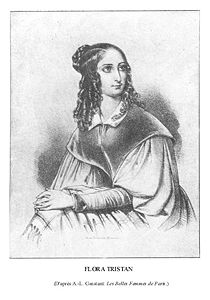Flora Tristan 1803 – 1844
April 27, 2009
 Flora
Tristan (1803-1844)
’… was a socialist writer and activist. She was one of the founders of
modern feminism. She wrote several works, the best known of which
are Peregrinations of a Pariah(1838), Promenades in London (1840),
and The Workers’ Union (1843). Tristan was the grandmother of the
painter Paul
Gauguin…’
Flora
Tristan (1803-1844)
’… was a socialist writer and activist. She was one of the founders of
modern feminism. She wrote several works, the best known of which
are Peregrinations of a Pariah(1838), Promenades in London (1840),
and The Workers’ Union (1843). Tristan was the grandmother of the
painter Paul
Gauguin…’
Flora Tristan was a patient of homeopath Jules John Mabit in 1844 (Susan Grogan, Flora Tristan: Life Stories, (Routledge, 1 Jun 2002). Page 202).
Flora was briefly romantically involved with Alphonse Louis Constant, otherwise known as Eliphas Levi.
From http://en.wikipedia.org/wiki/Flora_Tristan ‘… Flora Tristan was also one of the founders of modern feminism and, through Alina María Chazal, Paul Gauguin’s grandmother. Her complete name was Flore Celestine Therèse Henriette Tristan Moscoso. Her father, Mariano Tristán y Moscoso, was an Arequipa born Peruvian colonel of the Spanish Navy, she is also niece of Pío de Tristan viceroy of Peru and her mother, Anne Laisney, a Frenchwoman. Her parents met in Bilbao, Spain during her father’s stay there. Flora Tristan authored several works, the best known of which are Peregrinations of a Pariah (1838), Promenades in London (1840), and The Workers’ Union (1843).
When her father died before her fifth birthday in 1807, the situation of Flora and her mother changed drastically from the high standards of living they were accustomed to, and for this reason they voyaged to Arequipa in 1832, to claim her paternal inheritance which was in possession of her uncle Pío de Tristán. She remained in Peru until July 16, 1834.
Though she never secured the inheritance that brought her there, Tristan wrote a travel diary about her experiences in Peru during the country’s tumultuous post-independence period. The diary was published in 1838 as Pérégrinations d’une paria.
Mario Vargas Llosa, in his historical novel The Way to Paradise, analyzes Flora Tristan and her grandson Paul Gauguin’s contrasting quests for the ideal life through their experiences outside their native France.
Flora Tristan wrote this essay in 1843 after an extensive rest in Peru and a short trip to Britain where she produced works on the social conditions along the Channel. The Worker’s Union was the last of her writings and gave her a public persona of political activist.
Through this work, one can compare Tristan to similar Utopian Socialists including Charles Fourier (whom she knew personally) and the works of the French Socialists, the Saint Simonians, whose works she had studied throughout the years.
Flora Tristan takes into account the studies and teachings of these previous socialists, but creates a different and arguably more effective solution to the suppression of not only the proletariats, but the working women as well. She is the first to acknowledge the undeniable connection between the freedom of the working class and the deliverance of women’s rights.
Tristan recognizes that the working class had been fighting for over twenty five years to no avail. Her suggested solution is to act and create a Worker’s Union. She sees a great advantage to this because “divided, you are weak and fall, crushed underfoot by all sorts of misery! Union makes power. You have numbers in your favor, and numbers mean a great deal.”
Through Union dues, she insists on plans to provide the proletariats’ children with safe havens and increased access to education, to build palaces for the ill and wounded workers, and reach out to manufacturers and financiers, including those among the nobility, in order to sustain and maintain such programs.
Although seemingly two different essays, Flora Tristan acknowledges the need for the liberation of women in order to complete the emancipation of the working class. The society is not whole and the working class itself is fractured.
She argues that once society fixes the pieces of the fissure (women’s rights) then the rest will fall into place. In a sense, women’s liberation will lead to the greatest good for the greatest amount of people thereby supporting a Utilitarian mindset.
Although thinking positively about women’s liberation, Tristan did recognize that in the post revolution French society, women would not be easily considered equal just because they are human beings. Therefore, Tristan had to make the argument based on a series of benefits to the male majority. By feeding into the male ego, she opens up a new line of communication that no socialist had been able to tap into before.
This effort at creating a common Union was the last before Flora Tristan’s death in 1844. By drawing and building upon her colleagues’ and mentors’ socialist concepts, she created a logical and reasonable plan that the proletariats could realistically achieve. She opted to change the angle previously attempted and was able to include women’s rights as an important lever in the machine to create an independent Worker’s Union.